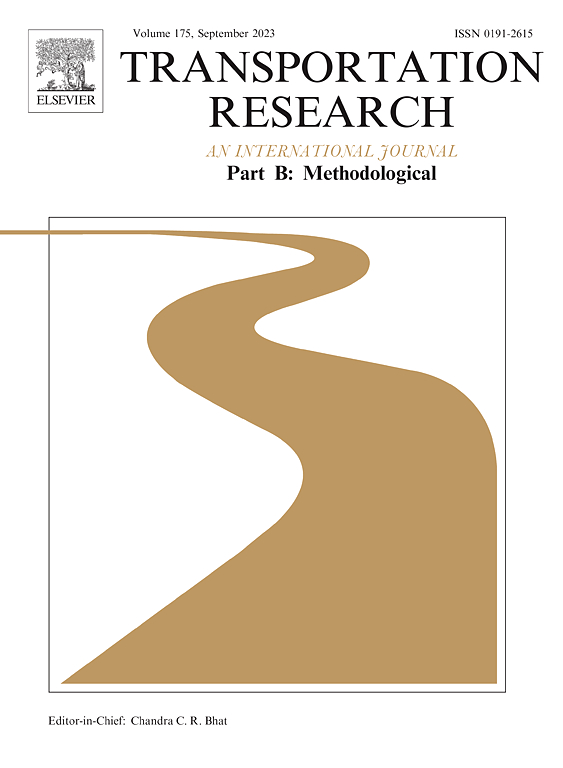There is something more fundamental than fundamental diagram
IF 5.8
1区 工程技术
Q1 ECONOMICS
引用次数: 0
Abstract
Revealing the inherent relationships among traffic flow characteristics, fundamental diagram has long been regarded as one of the pillars of traffic flow theory since Greenshields seminal work. When it is combined with the law of (mass/vehicle) conservation, dynamic modelling of traffic flow at the macroscopic level such as LWR and others have thrived. This paper shows that fundamental diagram is only a shadow of something more fundamental, i.e., phase diagram, which is originated from first principles of physics. At the microscopic level, traffic flow can be analyzed by examining the relative motion of two vehicles in car following. When the coordinate system is fixed on the leading vehicle, the Hamiltonian of this system can be defined as the total energy of the system. Conservation of total energy is established by incorporating physical entities (vehicles) and non-physical entities (drivers), the latter of which is enabled by the field theory of traffic flow. Consequently, the Hamilton's equations stipulate a vector field that constitutes the phase diagram of the system which, in turn, specifies Hamiltonian flow swirling around some equilibrium points. When focusing on the equilibrium points, the phase diagram reduces to the fundamental diagram, during which process much information is lost. Consequently, the lost information obscures the origin of the equilibrium points and further the fundamental diagram. This research roots traffic flow theory in first principles of physics and offers an example to address the dynamics of similar systems that involve human intelligence.
有比基本图更基本的东西
基本图揭示了交通流特征之间的内在关系,自格林希尔兹的开创性工作以来一直被视为交通流理论的支柱之一。当它与(质量/车辆)守恒定律相结合时,LWR等宏观层面的交通流动态建模得到了蓬勃发展。本文指出,基本图只是源于物理第一性原理的更基本的相图的影子。在微观层面上,可以通过检测汽车跟随中两车的相对运动来分析交通流。当坐标系固定在领头车辆上时,该系统的哈密顿量可以定义为该系统的总能量。总能量守恒是通过将物理实体(车辆)和非物理实体(驾驶员)结合起来建立的,后者是通过交通流场理论实现的。因此,汉密尔顿方程规定了一个矢量场,该矢量场构成了系统的相图,而相图又规定了围绕某些平衡点旋转的哈密顿流。当聚焦于平衡点时,相图会简化为基本图,在此过程中会丢失很多信息。因此,丢失的信息模糊了平衡点的原点,进一步模糊了基本图。这项研究将交通流理论根植于物理学的第一原理,并为解决涉及人类智能的类似系统的动力学问题提供了一个例子。
本文章由计算机程序翻译,如有差异,请以英文原文为准。
求助全文
约1分钟内获得全文
求助全文
来源期刊
CiteScore
12.40
自引率
8.80%
发文量
143
审稿时长
14.1 weeks
期刊介绍:
Transportation Research: Part B publishes papers on all methodological aspects of the subject, particularly those that require mathematical analysis. The general theme of the journal is the development and solution of problems that are adequately motivated to deal with important aspects of the design and/or analysis of transportation systems. Areas covered include: traffic flow; design and analysis of transportation networks; control and scheduling; optimization; queuing theory; logistics; supply chains; development and application of statistical, econometric and mathematical models to address transportation problems; cost models; pricing and/or investment; traveler or shipper behavior; cost-benefit methodologies.

 求助内容:
求助内容: 应助结果提醒方式:
应助结果提醒方式:


